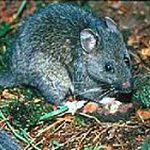A packrat, also called a woodrat, can be any of the species in the rodent genus Neotoma. Packrats have a rat-like appearance, with long tails, large ears and large black eyes. Compared to deer mice, harvest mice, and grasshopper mice packrats are noticeably larger and are usually somewhat larger than cotton rats.
Each species of pack rat is generally restricted to a given type of habitat within its range. Packrats live anywhere from low, hot, dry deserts to cold, rocky slopes above timberline. Packrats build complex houses or dens made of twigs, cactus joints and other materials. These contain several nest chambers, food caches as well as debris piles. Dens are often built in small caves or rocky crevices, but when close by human habitations, woodrats will opportunistically move into the attics and walls of houses
Packrats are nest builders. They use plant material like branches, twigs, sticks, and other available debris. Getting into everything from attics to car engines, stealing their “treasures”, damaging electrical wiring and creating general noisy havoc can easily cause them to become a nuisance. A peculiar characteristic is that if they find something they want, they will drop what they are currently carrying, for example a piece of cactus, and “trade” it for the new item. They are particularly fond of shiny objects. They can also be quite vocal and boisterous, sounding at times as if a “family rift” is taking place.
Packrats are known for their characteristic searching of materials to bring back to their dens. These dens can have several debris piles or “middens” where rejected material is put. In natural environments, the dens are normally built out of sticks, cactus joints, rocks or other materials, which are built up in a large pile and provide protection from predators and against thermal fluctuations.
Active pack rat midden in northern Nevada.
In the absence of rock crevices or caves, the dens are often built under trees or bushes. The pack rats will also use plant fragments, animal dung and small rocks in building the den. The vast majority of the materials will be from a radius of several dozen yards of the nest. Woodrats often urinate on the debris piles; sugar and other substances in the urine crystallize as it dries out, creating a material known as amberat, which under some conditions can cement the midden together. The resilience of the middens is due to three factors. The crystallized urine dramatically slows the decay of the materials in the midden. The dry climate of the American Southwest further slows the decay, and middens that are protected from the elements under rock overhangs or in caves survive even longer.

